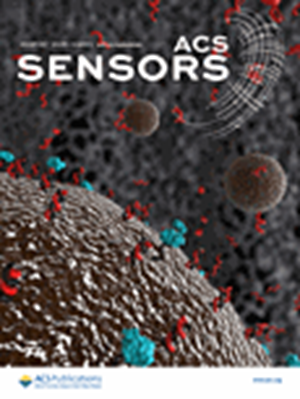Ultrasensitive Quantification of Thyroid-Stimulating Hormone and Thyroxine by Nanoelectronic SnS2 Transistor Sensors.
IF 8.2
1区 化学
Q1 CHEMISTRY, ANALYTICAL
引用次数: 0
Abstract
The measurement of thyroid hormones in serum is widely regarded as the most valuable single laboratory tool for assessing thyroid function. This study presents a highly sensitive tin disulfide nanosheet-fabricated field-effect transistor (SnS2-FET) designed for the detections of human thyroid-stimulating hormone (hTSH) and thyroxine (T4). By co-modifying an antibody (AbTSH for detecting hTSH), or a DNA aptamer (AptT4 for detecting T4), with polyethylene glycol (PEG) on the SnS2-FET channel surface, the PEG:AbTSH/SnS2-FET and PEG:AptT4/SnS2-FET devices achieve highly sensitive and selective detections of hTSH and T4, respectively, even in a high ionic strength buffer (1× PBS) or undiluted serum. With a low limit of detection (in the femtomolar level) and a wide linear working range (spanning at least 6 orders of magnitude of analyte concentration), the PEG:AbTSH/SnS2-FET immunosensor and PEG:AptT4/SnS2-FET aptasensor can detect the hTSH and T4 levels encountered in the spectrum of thyroid disorders. Notably, these specific receptor-modified SnS2-FET devices display negligible cross-reactivity with other pituitary hormones or serum components. This research indicates that the nanoelectronic SnS2-FET sensor platforms hold significant potential for point-of-care clinical diagnostics, particularly for the ultrasensitive detection and early screening of medical conditions.纳米电子SnS2晶体管传感器对促甲状腺激素和甲状腺素的超灵敏定量分析。
血清中甲状腺激素的测定被广泛认为是评估甲状腺功能最有价值的单一实验室工具。本研究提出了一种高灵敏度的二硫化锡纳米片场效应晶体管(SnS2-FET),用于检测人促甲状腺激素(hTSH)和甲状腺素(T4)。通过在SnS2-FET通道表面用聚乙二醇(PEG)共修饰抗体(AbTSH用于检测hTSH)或DNA适体(AptT4用于检测T4), PEG:AbTSH/SnS2-FET和PEG:AptT4/SnS2-FET装置分别实现对hTSH和T4的高灵敏度和选择性检测,即使在高离子强度缓冲液(1倍PBS)或未稀释的血清中也是如此。PEG:AbTSH/SnS2-FET免疫传感器和PEG:AptT4/SnS2-FET免疫传感器具有低检测限(飞莫水平)和宽线性工作范围(跨越至少6个数量级的分析物浓度),可以检测甲状腺疾病谱中遇到的hTSH和T4水平。值得注意的是,这些特异性受体修饰的SnS2-FET器件与其他垂体激素或血清成分的交叉反应性可以忽略不计。这项研究表明,纳米电子SnS2-FET传感器平台在即时临床诊断方面具有巨大的潜力,特别是在超灵敏检测和医疗条件的早期筛查方面。
本文章由计算机程序翻译,如有差异,请以英文原文为准。
求助全文
约1分钟内获得全文
求助全文
来源期刊

ACS Sensors
Chemical Engineering-Bioengineering
CiteScore
14.50
自引率
3.40%
发文量
372
期刊介绍:
ACS Sensors is a peer-reviewed research journal that focuses on the dissemination of new and original knowledge in the field of sensor science, particularly those that selectively sense chemical or biological species or processes. The journal covers a broad range of topics, including but not limited to biosensors, chemical sensors, gas sensors, intracellular sensors, single molecule sensors, cell chips, and microfluidic devices. It aims to publish articles that address conceptual advances in sensing technology applicable to various types of analytes or application papers that report on the use of existing sensing concepts in new ways or for new analytes.
 求助内容:
求助内容: 应助结果提醒方式:
应助结果提醒方式:


